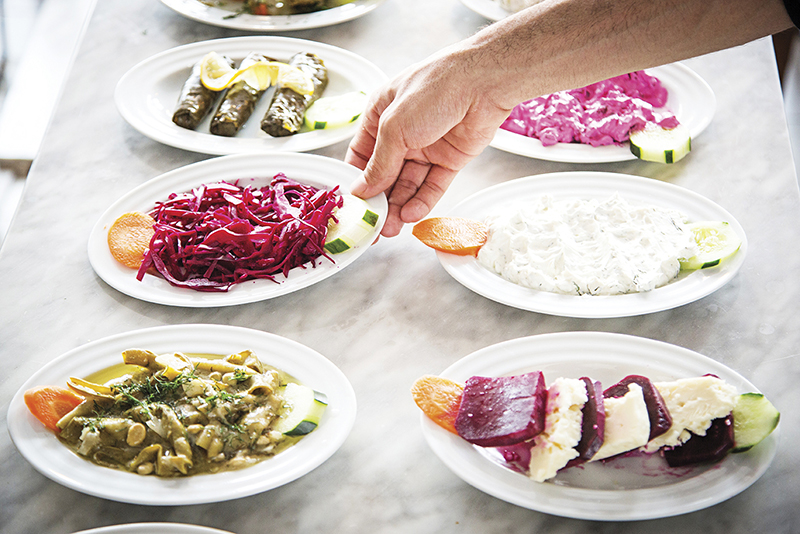Food & Drink
Talking Turkey
Turkish restaurant Mare Nostrum is a great addition to Fells Point.
With The Black Olive, Ouzo Bay, Kali’s Court, and the Inn at the Black Olive all within a fig’s throw of each other, Baltimore is somewhat saturated when it comes to Mediterranean coastal cuisine. So when a new restaurant joined the ranks several months back, I wondered how it might set itself apart from the scene.
For starters, Mare Nostrum (Latin for “our sea” and the Roman name for the Mediterranean), owned by Turkish natives Murat Mercan and Merter Akbay, has Ottoman Empire inflections. Though the Turks and the Greeks share cultural and culinary similarities, in Turkey, dedicated seafood spots, taverns serving mezes (called meyhane), and kebab cafes are the most commonly found eating establishments. Mare Nostrum—with more than 20 mezes to mull, a selection of grilled meats (chicken, lamb, and beef), plus several seafood options—is a combination of all three.
Set on the site of a former sub shop across from the Broadway Market, the interior décor dazzles with white marble-topped tables and charming folk art from a coastal Turkish port city evoking the sun-splashed simplicity of the Aegean islands. Turkish talismans are a focal point, too, including evil eyes and a wall of amethyst crystals to offer protection and good luck. If my recent visits are any indication, these amulets seem to be working their charms in the kitchen.
At lunchtime, my dining companion and I started off with a refreshing “mare salad”—romaine, tomatoes, radish, spring onions, and a sheep’s milk Turkish feta that was the creamiest I’ve had this side of Istanbul.
We also shared a smooth and garlicky hummus and manti, a traditional Turkish beef ravioli dish that floated on a yogurt sauce and was enlivened by a drizzle of red pepper oil. The house-made noodles were delicate and delicious, though they were a bit lost in the sauce. That being said, the tangy yogurt gave us ample opportunity to make use of the fresh-baked pita, a chewy, sesame-flecked flatbread that proved the perfect partner for sopping.
For a true taste of Turkey, we shared adana kebap, one of the country’s signature lamb dishes.
For a true taste of Turkey, we shared the adana kebap, one of the country’s signature kebab dishes of ground lamb seasoned with hot pepper and cumin that had a distinct fire-grilled flavor and was prettily presented with a complement of bulgar, charred tomatoes, and peppers.
On an ensuing dinner visit, we were wowed by the marble meze cart—a show-stopping, two-tiered display with some 20 cold mezes—that rolls out after 5 p.m. With everything laid out so beautifully before us, it was hard not to want it all. While our waiter gave us a full briefing, we salivated at the sights, and kept pointing as he wrote down samphire (sea beans), saksuka (dried eggplant with peppers and tomatoes), cevizli kabak (fried zucchini and carrots mixed with mayonnaise, yogurt, and walnuts), and “Pink Sultan” (red beet, yogurt, and garlic dip). Each dish was delectable and the embodiment of coastal cooking with an emphasis on fresh vegetables, yogurt-based sauces, and extra-virgin olive oil.
While the mezes are a menu must, we also enjoyed the alexandros garides, a satisfying stew of sautéed shrimp, capers, onions, peppers, and feta cheese baked and served in a clay pot, which stayed hot from start to finish. Although it was listed on the appetizer portion of the menu, we took our server’s advice to order it as a main course, and it was more than ample. The only dish that missed the mark was a whole grilled bronzino dressed with lemon and arugula. The fact that the menu makes a point of mentioning that it’s “delivered fresh daily from the Aegean Sea,” made us sad that the sorely overcooked fish had travelled so far to be so terribly treated. It was difficult to dislodge the flesh from the skin, so after only a few bites, we gave up. Much to his credit, our waiter offered to take it back and bring us another dish, but we declined having had more than our fill of the hors d’ouevres.
Dessert, on the other hand, was flawless. Some chefs lose their steam by the time they get to the sweet stuff, but that’s not the case here. We indulged in the fistikli kadayif— phyllo dough rolled with cheese, vanilla syrup, and lemon—and the beautifully textured kunefe—a warm nest of shredded phyllo dough rolled with cheese, pistachios, and drenched in vanilla syrup. Both were exceptional and helped us forgive—and forget—the regrettable fish dish. For a counterpoint to the sweets, don’t miss the seriously strong Turkish coffee (served with a complimentary Turkish delight confection).
On both visits, service was excellent. On our first visit, our waiter informed us that Broadway Liquors just up the block keeps raki on hand for patrons of the BYOB spot. On our second visit, we heeded his advice, picked up a bottle of the anise-flavored Turkish national drink, and toasted serefe.
